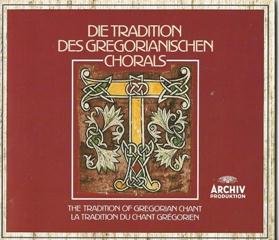The Tradition of Gregorian Chant CD 4 Ambrosian Chant (2007)
The Tradition of Gregorian Chant CD 4 Ambrosian Chant (2007)

Altspanische Gesänge 1.Kyrie I 2. II 3.Kyrie III 4.Gloria 5.Sacrificium: Offerte Domino 6.Sanctus 7.Agnus Dei I 8.Agnus Dei II 9.Antiphon (Laud): Statuit Dominus 10.Lamentatio Ieremiae Prophetae: Aleph, Ego vir videns Cantus Missarum 11.Ingressa: Respice in me 12.Psalmellus: Pacifice loquebantur 13.Alleluia: Magi venerunt 14.Ante Evangelium: In Bethlehem Judae 15.Post Evangelium: Coenae tuae 16.Ante Evangelium: Laudate Dominum 17.Post Evangelium: Domine, Domine Deus 18.Offertory: Ubi sunt nunc dii 19.Contrafactorium: Ille homo 20.Transitorium: Gaude et laetare 21.Transitorium: Te laudamus Ambrosianischer Choral Cantus Officiorum 22.Hymn: Splendor paternae gloriae 23.Hymn: Agnes beatae virginis 24.Hymn: Apostolorum passio 25.Antiphon: Omnes patriarchae 26.Responsory: Tenebrae factae sunt 27.Antiphon: Rorate caeli 28.Antiphon: In exitu Israel 29.Antiphon (duplex): Venite omnis creatura 30.Psallenda: Pax in caelo 31.Psallenda: Videntes stellam magi Coro de la Abadìa de Santo Domingo de Silos, Dom Ismael Fernandez de la Cuesta (1 – 10) Capella Musicale del Duomo di Milano, Monsignore Luciano (11 – 31)
Milan, the "second city" of medieval Italy after Rome, tenaciously clung to its local liturgical privileges. Legend credits the Milanese with defying even Charlemagne in defense of the so-called Ambrosian chant. This liturgy, specific to the diocese of Milan, spread to most of northern Italy and even some parts of present-day Austria; elements of the peculiar chant even survived the Council of Trent. Its name derives from St. Ambrose, the fourth century bishop of Milan and the supposed founder of the chant. At the very least, Ambrose was seminal for the early liturgical hymn, though hymns are strangely sparse in the Ambrosian repertory. The Ambrosian chant never grew to the bloated size of the pre-Tridentine repertory of Gregorian chant, but it maintained its own distinct musical traditions and liturgical forms.
Musically, many specific Ambrosian melodies in the Middle Ages also resisted the winds of change and may have traveled to later times in similar forms. Numerous other examples exist of Ambrosian chants that bear a filial relationship to Gregorian or Old Roman chants; often a process of musical embellishment clarifies that relationship. As with Gregorian chant, the Ambrosian melodies frequently display signs of motivic expansion by the addition of small melodic cells, perhaps indicating improvisation or oral transmission. The Ambrosian melodies tend to progress more often in stepwise motion than the Gregorian ones and span a much wider spectrum of style from one chant to another: extremely elaborate and solemn melismatic chants live alongside the simplest syllabic settings.
The forms and classifications of Ambrosian chants are sometimes parallel to those for Gregorian chant, but with prominent exceptions. The Ambrosian liturgical year follows only two main divisions, summer and winter (following an alternation between the two principal churches of medieval Milan). The Ambrosian Mass Ordinary only consists of a simply set Gloria, Credo, and Sanctus. Several of the distinctly Ambrosian Mass Propers (which also evolved from psalmodic antiphons) correspond to similar Gregorian forms: Ingressa (Introit), Post-Evangelium (Gradual), Cantus/Alleluia (Tract/Alleluia), Offrenda (Offertory), and Confractorium. Some elements of the Ambrosian Office expand upon the Gregorian liturgy: though the Ambrosian rite, for instance, conflates the Offices of Matins and Lauds, on festal days it adds an elaborate antiphona ad crucem during a mid-service procession, a Gloria patri, two processional psallendae, and a responsory in baptistero during concluding stational processions. Ambrosian Vespers, similarly, add an opening Lucernarium and on Sundays and feasts and an extra Vigil at the conclusion. --- Timothy Dickey, Rovi
download (mp3 @320 kbs):
yandex 4shared mega mediafire zalivalka cloudmailru uplea ge.tt
Last Updated (Wednesday, 02 November 2016 19:31)
